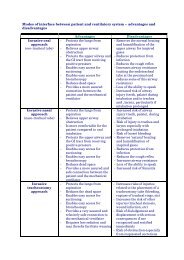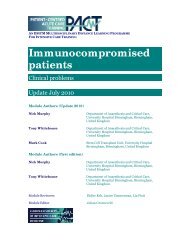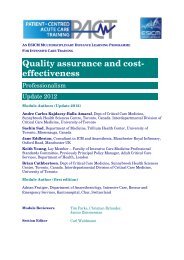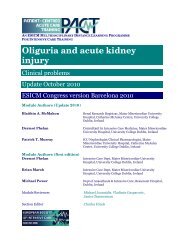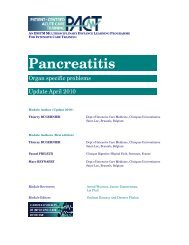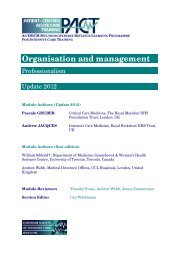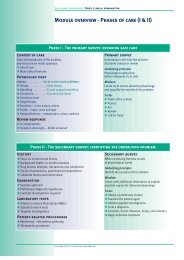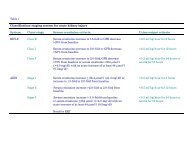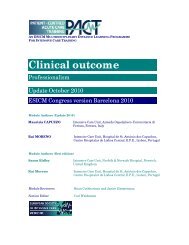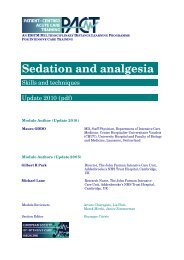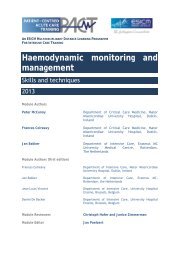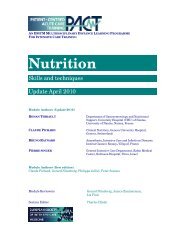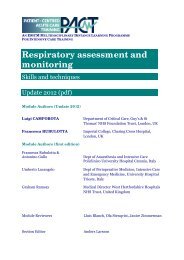Burns injury - PACT - ESICM
Burns injury - PACT - ESICM
Burns injury - PACT - ESICM
Create successful ePaper yourself
Turn your PDF publications into a flip-book with our unique Google optimized e-Paper software.
1/ PRE-HOSPITAL/IMMEDIATE CARE<br />
Priorities including the primary survey<br />
The main responsibilities in the pre-hospital setting are safety for the patient(s) and<br />
the rescue crew, to stop the burning process and to perform ABCDEF (airway,<br />
breathing, circulation, disability, environment, fluid) assessment and treatment.<br />
Thereafter a gross estimation of the burned surface (%TBSA) should be carried out.<br />
Pre-hospital estimation of %TBSA is difficult and frequently an overestimation of<br />
smaller burns and an underestimation of larger burns takes place. For detail of the<br />
estimation of the %TBSA burned, see Task 2.<br />
Hettiaratchy S, Papini R. Initial management of a major burn: I--overview. BMJ<br />
2004; 328(7455): 1555–1557. PMID 15217876<br />
Allison K, Porter K. Consensus on the prehospital approach to burns patient<br />
management. Emerg Med J 2004; 21(1): 112–114. PMID 14734397<br />
Collis N, Smith G, Fenton OM. Accuracy of burn size estimation and subsequent<br />
fluid resuscitation prior to arrival at the Yorkshire Regional <strong>Burns</strong> Unit. A<br />
three year retrospective study. <strong>Burns</strong> 1999; 25: 345–351. PMID 10431984<br />
Cooling<br />
Most textbooks advocate cooling of the burn <strong>injury</strong> until pain relief with 12–15 C<br />
(never ice) clean water. It is claimed that cooling stops the thermal <strong>injury</strong>, reduces<br />
oedema and relieves pain. Studies have shown that the most significant reduction of<br />
temperature in burned tissue takes place within few minutes after the start of<br />
cooling. Cooling beyond two to three minutes is therefore of questionable value.<br />
Remember that cooling often causes hypothermia in patients with large burns.<br />
Herndon DN, editor. Total Burn Care. 3rd edition. Edinburgh: Saunders-Elsevier;<br />
2007. ISBN 978-1416032748<br />
Trupkovic T, Hoppe U, Kleinschmidt S, Sefrin P. Correspondence (letter to the<br />
editor): benefits of cooling are not known. Dtsch Arztebl Int 2010;<br />
107(6): 101. PMID 20204125<br />
Hypothermia<br />
Hypothermia, defined as a core body temperature 70% TBSA) the<br />
incidence may increase to 35%. Hypothermia is associated with increased fluid<br />
requirement, coagulopathy, depressed cardiac function, dysrhythmias, ventilatory<br />
depression, decreased oxygen delivery, acidosis, and a higher mortality.<br />
3



